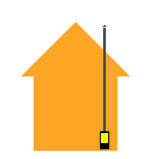Tar and soot condensates in chimneys
When wood or coal is burnt impurities are present in the flue gases released. 50 degrees C is the dew point of the condensates in the flue gases and tar and impurities in the flue gases will condensate on surfaces in the flue and chimney.
Because a stove is a lot more efficient than a fireplace (often 75% more efficient than an open fire) more of the heat from the fuel is transferred to the room. Thus the flue gases are colder. Therefore tar condensation is a bigger problem with stoves than it is with a fireplace. Because wood does not burn as hot as coal a stove burning wood will tend to result in more condensates in the chimney than one burning coal.
So when installing a stove this is the reason why we use twin wall insulated flue pipe, pumice liners (which form an insulated masonry chimney), and insulated flexible flue liners. All these products create an insulated chimney in which the flue gases are kept as hot as possible and thus tar deposits are kept to a minimum.
Upsizing your chimney liner size
You still have to sweep insulated chimneys once a year as deposits will still build up. These deposits form what looks a little like "fur" on the inside of the liner. These deposits reduce the cross-sectional area inside the liner, reducing the draw of the chimney, and thus reducing the effectiveness and safety of the stove. For 125mm stoves there is a building regulation guidance to increase the flue size to 150mm. Read about some potential problems with upsizing your chimney here
Damage caused by chimney condensates
The tars and acids that are deposited in chimneys will corrode and compromise lime and cement based mortars. This can occur to the extent that it is sometimes possible to lift bricks off the top of the chimney by hand. This can compromise the integrity of the chimney, which then increases the risk of the fire spreading should there be a chimney fire.
Tar and condensates may also leak out of the chimney and come through the chimney breast where they are a nuisance as they discolour the wall and ruin the decor.



